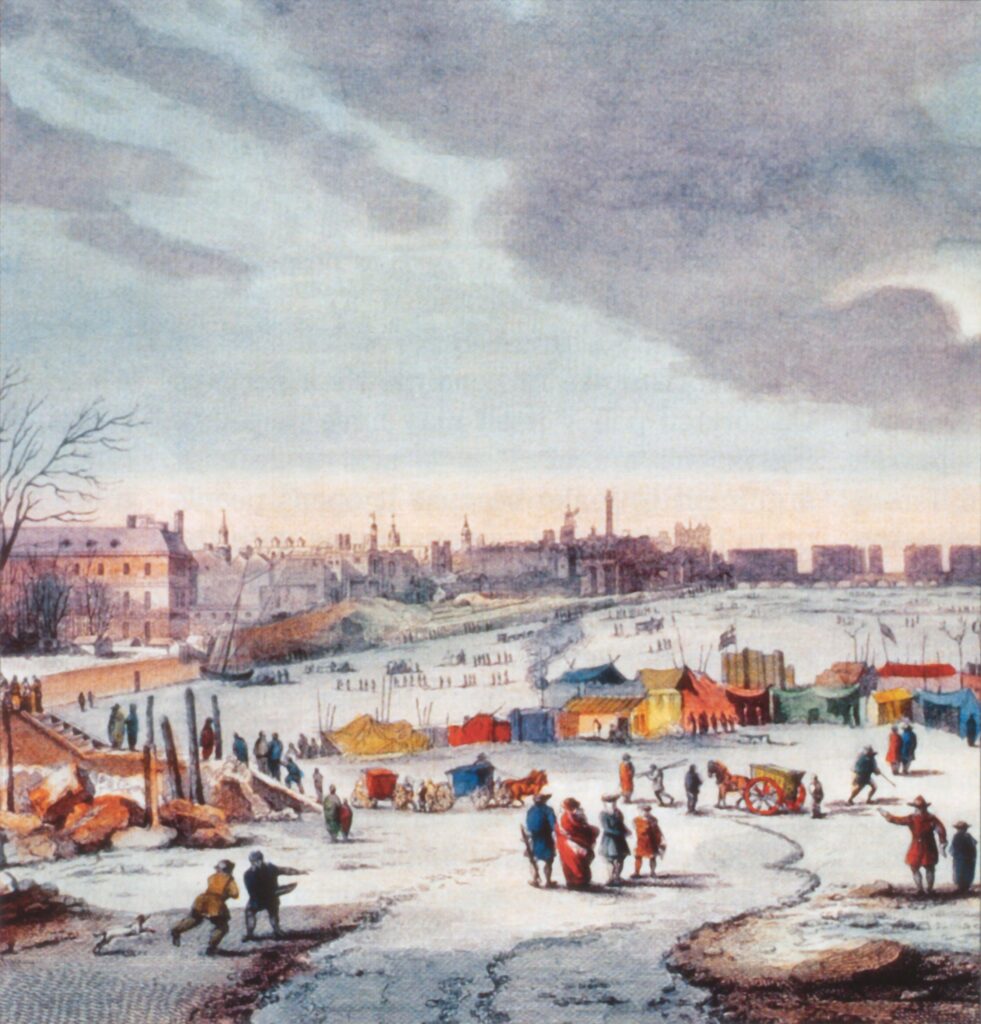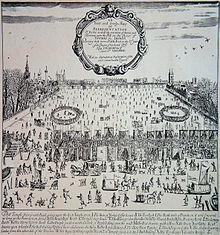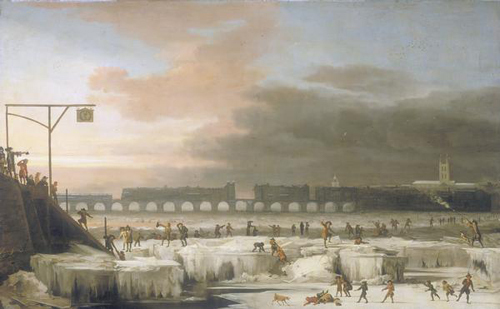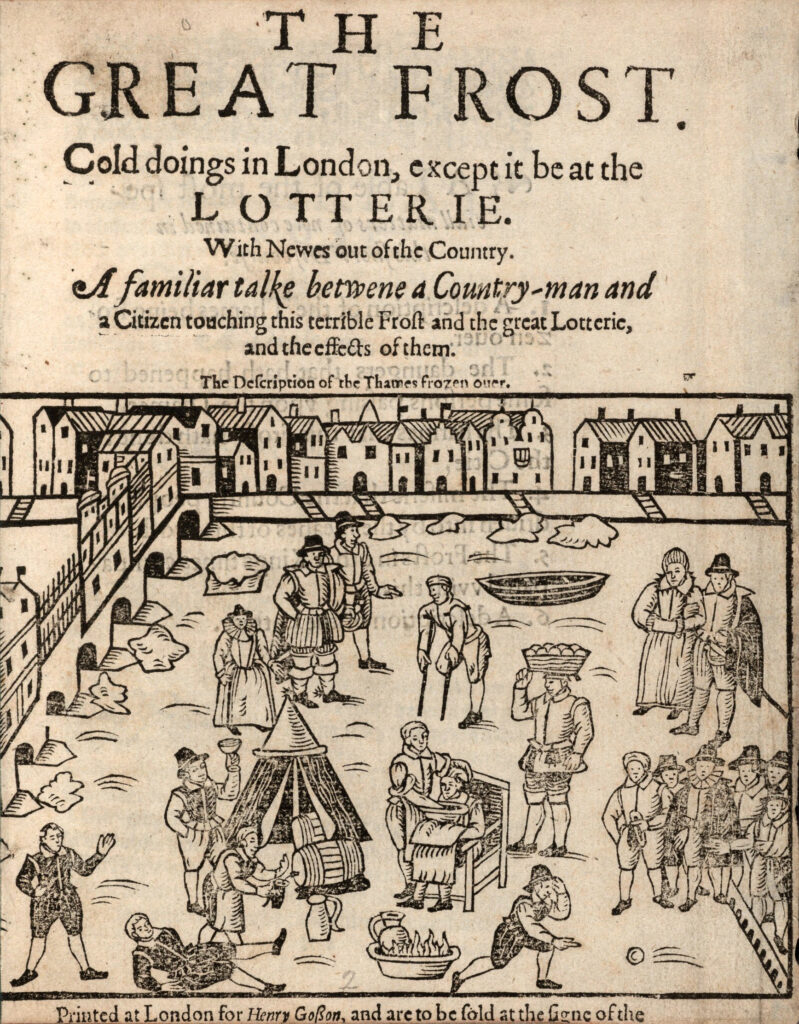
The River Thames frost fairs were held on the tideway of the River Thames in London, England in some winters, starting at least as early as the late 7th century all the way until the early 19th century. Most were held between the early 17th and early 19th centuries during the period known as the Little Ice Age, when the river froze over most frequently. During that time the British winter was more severe than it is now, and the river was wider and slower, further impeded by the medieval Old London Bridge.
The first recorded frost fair for which the term “frost fair” was used was in 1608. Activities at the frost fair included dancing, football, nine-pin bowling, and unlicensed gambling.There were barbers,selling of fruit, shoemakers, and pubs. The shoemakers had fires inside of their tents to stay warm.
1683-84
The most celebrated frost fair occurred in the winter of 1683–84. Activities included football, horse and coach racing, ice skating, nine-pin bowling, puppet plays, and sledding. There were also other activities that would be considered cruel or controversial in present times, or even illegal. They included bull-baiting, fox hunting, and throwing at cocks.
John Evelyn’s account of the 1683-84 frost fair:
Coaches plied from Westminster to the Temple, and from several other stairs too and fro, as in the streets; sleds, sliding with skeetes, a bull-baiting, horse and coach races, puppet plays and interludes, cooks, tipling and other lewd places, so that it seemed to be a bacchanalian triumph, or carnival on the water.
For sixpence, the printer Croom sold souvenir cards written with the customer’s name, the date, and the fact that the card was printed on the Thames; he was making five pounds a day (ten times a labourer’s weekly wage). King Charles II bought one. The cold weather was not only a cause for merriment, as Evelyn explained:
The fowls, fish and birds, and all our exotic plants and greens universally perishing. Many parks of deer were destroyed, and all sorts of fuel so dear that there were great contributions to keep the poor alive…London, by reason for the excessive coldness of the air hindering the ascent of the smoke, was so filled with the fuliginous steam of the sea-coal …that one could hardly breath.

The Frost Fair of 1683
An eye-witness account of the 1683–84
On the 20th of December, 1688 [misprint for 1683], a very violent frost began, which lasted to the 6th of February, in so great extremity, that the pools were frozen 18 inches thick at least, and the Thames was so frozen that a great street from the Temple to Southwark was built with shops, and all manner of things sold. Hackney coaches plied there as in the streets. There were also bull-baiting, and a great many shows and tricks to be seen. This day the frost broke up. In the morning I saw a coach and six horses driven from Whitehall almost to the bridge (London Bridge) yet by three o’clock that day, February the 6th, next to Southwark the ice was gone, so as boats did row to and fro, and the next day all the frost was gone. On Candlemas Day I went to Croydon market, and led my horse over the ice to the Horseferry from Westminster to Lambeth; as I came back I led him from Lambeth upon the middle of the Thames to Whitefriars’ stairs, and so led him up by them. And this day an ox was roasted whole, over against Whitehall. King Charles and the Queen ate part of it.
Thames frost fairs were often brief, scarcely commenced before the weather lifted and the people had to retreat from the melting ice. Rapid thaws sometimes caused loss of life and property. In January 1789, melting ice dragged a ship which was anchored to a riverside public house, pulling the building down and causing five people to be crushed to death.
18th century
There were frost fairs in 1715-16, 1739-40, and 1789.
Frost fair, 1814 (last frost fair)

The Frost Fair of 1814, by Luke Clenell.
The frost fair of 1814 began on 1 February, and lasted four days, between Blackfriars Bridge and London Bridge. An elephant was led across the river below Blackfriars. Temperatures had been below freezing every night from 27 December 1813 to 7 February 1814 and numerous Londoners made their way onto the frozen Thames.
Tradesmen of all types set up booths to sell their wares, and pedlars circulated through the crowd. Food and drink was being sold including beef, Brunswick Mum, coffee, gin, gingerbread, hot apples, Old Tom gin, roast mutton, hot chocolate, purl (wormwood ale), and black tea. Activities included dancing and nine-pin bowling.
As the ice broke up starting on 5 February, several people drowned.
Nearly a dozen printing presses were also on the ice, producing commemorative poems. A printer named George Davis published a 124-page book, Frostiana; or A History of the River Thames In a Frozen State: and the Wonderful Effects of Frost, Snow, Ice, and Cold,in England, and in Different Parts of the World Interspersed with Various Amusing Anecdotes. The entire book was typeset and printed in Davis’s printing stall which had been set up on the frozen Thames. The book contained an account of the frost, humorous sayings, anecdotes, various weather-related histories and specifics about “skaiting” according to a 1814 review.
This was the last frost fair. The climate was growing milder; old London Bridge was demolished in 1831 and replaced with a new bridge with wider arches, allowing the tide to flow more freely; and the river was embanked in stages during the 19th century, all of which made the river less likely to freeze. There was nearly a frost fair in 1881. Andrews (1887) noted the severe winter of 1881, saying, “it was expected by many that a Frost Fair would once more be held on the Thames”.



